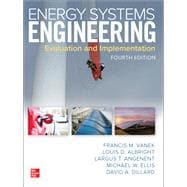Preface to the Fourth Edition
Acknowledgments
Note to Instructors
1. Introduction
1-1. Overview
1-2. Introduction
1-3. Relationship between Energy, Population, and Wealth
1-4. Pressures Facing World due to Energy Consumption
1-5. Energy Issues and the Contents of This Book
1-6. Units of Measure Used in Energy Systems
1-7. Summary
References
Further Reading
Exercises
2. Engineering Economic Tools
2-1. Overview
2-2. Introduction
2-3. Economic Analysis of Energy Projects and Systems
2-4. Direct versus External Costs and Benefits
2-5. Intervention in Energy Investments to Achieve Social Aims
2-6. NPV Case Study Example
2-7. Summary
References
Further Reading
Exercises
3. Climate Change and Climate Modeling
3-1. Overview
3-2. Introduction
3-3. Modeling Climate and Climate Change
3-4. Climate in the Future
3-5. Summary
References
Further Reading
Exercises
4. Fossil Fuel Resources
4-1. Overview
4-2. Introduction
4-3. Decline of Conventional Fossil Fuels and a Possible Transition to Nonconventional Alternatives
4-4. Summary
References
Further Reading
Exercises
5. Stationary Combustion Systems
5-1. Overview
5-2. Introduction
5-3. Fundamentals of Combustion Cycle Calculation
5-4. Advanced Combustion Cycles for Maximum Efficiency
5-5. Economic Analysis of Stationary Combustion Systems
5-6. Incorporating Environmental Considerations into Combustion Project Cost Analysis
5-7. Reducing CO2 by Capturing Emissions
5-8. Systems Issues in Combustion in the Future
5-9. Representative Levelized Cost Calculation for Electricity from Natural Gas
5-10. Summary
References
Further Reading
Exercises
6. Energy Conservation
6-1. Overview
6-2. Role of Conservation in Energy Sustainability
6-3. Understanding Energy Efficiency
6-4. Energy Conservation in Buildings
6-5. Energy Conservation through Appliance Selection and Operation
6-6. Energy Conservation in Industry
6-7. Energy Conservation in Agriculture, Water, and Food Production
6-8. Conclusion
References
Further Reading
Exercises
7. Carbon Sequestration
7-1. Overview
7-2. Introduction
7-3. Indirect Sequestration
7-4. Geological Storage of CO2
7-5. Sequestration through Conversion of CO2 into Inert Materials
7-6. Direct Removal of CO2 from Atmosphere for Sequestration
7-7. Overall Comparison of Sequestration Options
7-8. Summary
References
Further Reading
Exercises
8. Nuclear Energy Systems
8-1. Overview
8-2. Introduction
8-3. Nuclear Reactions and Nuclear Resources
8-4. Reactor Designs: Mature Technologies and Emerging Alternatives
8-5. Nuclear Fusion
8-6. Nuclear Energy and Society: Environmental, Political, and Security Issues
8-7. Representative Levelized Cost Calculation for Electricity from Nuclear Fission
8-8. Summary
References
Further Reading
Exercises
9. The Solar Resource
9-1. Overview
9-2. Introduction
9-3. Definition of Solar Geometric Terms and Calculation of Sun’s Position by Time of Day
9-4. Effect of Diffusion on Solar Performance
9-5. Summary
References
Further Reading
Exercises
10. Solar Photovoltaic Technologies
10-1. Overview
10-2. Introduction
10-3. Fundamentals of PV Cell Performance
10-4. Design and Operation of Practical PV Systems
10-5. Life-Cycle Energy and Environmental Considerations
10-6. Representative Levelized Cost Calculation for Electricity from Solar PV
10-7. Summary
References
Further Reading
Exercises
11. Active Solar Thermal Applications
11-1. Overview
11-2. Symbols Used in This Chapter
11-3. General Comments
11-4. Flat-Plate Solar Collectors
11-5. Concentrating Collectors
11-6. Heat Transfer in Flat-Plate Solar Collectors
11-7. Summary
References
Further Reading
Exercises
12. Passive Solar Thermal Applications
12-1. Overview
12-2. Symbols Used in This Chapter
12-3. General Comments
12-4. Thermal Comfort Considerations
12-5. Building Enclosure Considerations
12-6. Heating Degree Days and Seasonal Heat Requirements
12-7. Types of Passive Solar Heating Systems
12-8. Solar Transmission through Windows
12-9. Load:Collector Ratio Method for Analysis
12-10. Conservation Factor Addendum to the LCR Method
12-11. Load:Collector Ratio Method for Design
12-12. Passive Ventilation by Thermal Buoyancy
12-13. Designing Window Overhangs for Passive Solar Systems
12-14. Summary
References
Exercises
13. Wind Energy Systems
13-1. Overview
13-2. Introduction
13-3. Using Wind Data to Evaluate a Potential Location
13-4. Estimating Output from a Specific Turbine for a Proposed Site
13-5. Turbine Design
13-6. Economic and Social Dimensions of Wind Energy Feasibility
13-7. Representative Levelized Cost Calculation for Electricity from Utility-Scale Wind
13-8. Summary
References
Further Reading
Exercises
14. Bioenergy Resources and Systems
14-1. Overview
14-2. Introduction
14-3. Biomass
14-4. Platforms
14-5. Alcohol
14-6. Biodiesel
14-7. Methane and Hydrogen (Biogas)
14-8. Summary
References
Further Reading
Exercises
15. Transportation Energy Technologies
15-1. Overview
15-2. Introduction
15-3. Vehicle Design Considerations and Alternative Propulsion Designs
15-4. Alternatives to ICEVs: Alternative Fuels and Propulsion Platforms
15-5. Well-to-Wheel Analysis as a Means of Comparing Alternatives
15-6. Summary
References
Further Reading
Exercises
16. Systems Perspective on Transportation Energy
16-1. Overview
16-2. Introduction
16-3. Recent Trends and Current Assessment of Energy Use in Transportation Systems
16-4. Applying a Systems Approach to Transportation Energy
16-5. Understanding Transition Pathways for New Technology
16-6. Toward a Policy for Future Transportation Energy from a Systems Perspective
16-7. Summary
References
Further Reading
Exercises
17. Other Technologies and Systems
17-1. Overview
17-2. Introduction
17-3. Biomass Energy Application for Heat and Power
17-4. Energy from Water: Hydropower, Tidal, and Wave Energy
17-5. Energy Extraction Using Heat Pumps
17-6. Energy Recovery from the Waste Stream
17-7. Summary
References
Further Reading
Exercises
18. Conclusion: Creating the Twenty-First-Century Energy System
18-1. Overview
18-2. Introduction: Energy in the Context of the Economic-Ecologic Conflict
18-3. Sustainable Energy for Developing Countries
18-4. Pathways to a Sustainable Energy Future: A Case Study
18-5. The Role of the Energy Professional in Creating the Energy Systems of the Future
18-6. Summary
References
Further Reading
Exercise
A. Guide to Online Appendices
Index









